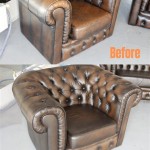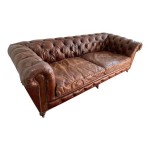How To Remove Ink Stains From Leather Sofa
Ink stains on a leather sofa can be a frustrating problem. Leather, while durable and aesthetically pleasing, is a porous material that can readily absorb ink. Addressing ink stains promptly and using the correct techniques is crucial to minimize damage and potentially restore the sofa to its original condition. This article will provide detailed instructions on various methods for removing ink stains from leather sofas, outlining the best approaches for different types of ink and leather.
Before attempting any stain removal method, it is imperative to identify the type of leather your sofa is made from. The most common types include aniline, semi-aniline, and pigmented leather. Aniline leather, also known as full-grain or naked leather, is the most delicate as it retains the natural markings and pores of the hide and has minimal protective coating. Semi-aniline leather has a light surface coating, offering slightly more protection against stains. Pigmented leather, also known as protected leather, has a polymer coating, which provides the most resistance to stains. Determining the type of leather will influence the choice of cleaning agents and techniques used.
A simple water drop test can help identify the leather type. Place a small drop of water on an inconspicuous area of the sofa. If the water is readily absorbed, the leather is likely aniline. If the water beads up for a short period before being absorbed, it is probably semi-aniline. If the water beads up and remains on the surface, it is likely pigmented leather. Once the leather type is identified, proceed with caution and test any cleaning solution on an unseen area before applying it to the stain.
Key Point 1: Immediate Action and Basic Stain Removal
The first moments after an ink stain occurs are critical. Immediate action can significantly improve the chances of successful stain removal. The primary goal is to prevent the ink from setting deeply into the leather fibers.
The first step is to blot the stain immediately with a clean, dry, white cloth or paper towel. Avoid rubbing the stain, as this can spread the ink and drive it deeper into the leather. Blot gently and repeatedly, working from the outside edges of the stain inward, to absorb as much of the fresh ink as possible. Continue blotting until no more ink is transferred to the cloth.
For minor, fresh ink stains, a simple solution of mild dish soap and water may be sufficient. Mix a few drops of dish soap with lukewarm water, creating a gentle lather. Dampen a clean cloth with the soapy solution, ensuring it is not soaking wet. Gently blot the ink stain with the damp cloth, again working from the outside in. After blotting, use a separate clean, damp cloth to rinse away any soap residue. Finally, pat the area dry with a clean, dry cloth. Allow the leather to air dry completely, away from direct sunlight or heat sources.
If the dish soap and water solution is ineffective, consider using rubbing alcohol (isopropyl alcohol). However, use rubbing alcohol with extreme caution, especially on aniline leather, as it can remove the leather's natural oils and potentially discolor the material. Before applying rubbing alcohol to the stain, test it on an inconspicuous area to ensure it does not cause discoloration or damage. If the test is satisfactory, dampen a cotton swab with rubbing alcohol and gently dab the ink stain, working from the outside in. Avoid saturating the leather. Use a clean cloth to blot the area dry immediately after applying the alcohol. Repeat the process if necessary, but avoid excessive rubbing. Once the stain is removed, apply a leather conditioner to replenish the leather's oils and prevent it from drying out.
Hair spray, particularly aerosol types, can also be effective for removing ink stains due to its alcohol content. Spray a small amount of hair spray onto a clean cloth and gently blot the ink stain. Again, work from the outside in and avoid saturating the leather. Use a clean, damp cloth to rinse the area and pat it dry. Test hair spray on an inconspicuous area first to ensure it does not damage the leather.
Key Point 2: Specialized Cleaning Products and Techniques
For more stubborn or older ink stains, specialized leather cleaning products designed specifically for ink removal may be necessary. These products typically contain solvents and detergents formulated to lift ink from leather without causing excessive damage or discoloration.
Leather ink remover pens are readily available and designed for targeted stain removal. Follow the manufacturer's instructions carefully. Typically, the pen is used to trace over the ink stain, and the ink remover is then blotted away with a clean cloth. These pens can be effective for small stains and can provide precise application.
Commercial leather cleaners, formulated specifically for removing ink stains, offer a broader application. These cleaners often come in spray or liquid form and are applied to the stain, allowed to sit for a brief period, and then blotted away. Always read and follow the manufacturer's instructions carefully. Ensure the cleaner is compatible with the type of leather on your sofa. Test the cleaner on an inconspicuous area before applying it to the stain.
Another option is using a homemade paste of cream of tartar and lemon juice. Mix equal parts of cream of tartar and lemon juice to form a thick paste. Apply the paste to the ink stain and allow it to sit for approximately 30 minutes. Gently wipe away the paste with a damp cloth and pat the area dry. Lemon juice has a mild bleaching effect, so use it cautiously, especially on dark-colored leather. Test the paste on an inconspicuous area first.
When using any cleaning product, whether commercial or homemade, it is crucial to work in a well-ventilated area to avoid inhaling potentially harmful fumes. Wear gloves to protect the skin from irritation. Avoid using harsh chemicals, such as bleach or acetone, as these can cause irreversible damage to the leather.
After using any cleaning product, it is imperative to condition the leather to replenish its natural oils. Leather conditioners help prevent the leather from drying out, cracking, or becoming discolored. Apply a leather conditioner according to the manufacturer's instructions, and allow it to absorb into the leather for the recommended time. Wipe away any excess conditioner with a clean cloth.
Key Point 3: Prevention and Professional Assistance
Prevention is the most effective strategy for avoiding ink stains on a leather sofa. Implementing preventative measures can minimize the risk of ink-related accidents and protect the sofa from damage.
Avoid using pens or markers near the leather sofa. Store them in a designated location away from the seating area. If pens are used, ensure they are capped securely when not in use. Consider using pen holders or organizers to keep pens organized and prevent them from accidentally rolling onto the sofa.
Regularly clean and condition the leather sofa to maintain its protective barrier. Dust the sofa regularly with a soft cloth to remove dirt and debris. Condition the leather every few months, or as recommended by the manufacturer, to keep it supple and resistant to stains. A well-maintained leather sofa is less susceptible to absorbing ink and easier to clean.
Consider applying a leather protector to the sofa. Leather protectors are designed to create a barrier on the surface of the leather, repelling liquids and preventing stains from penetrating deeply. These protectors are available in spray or liquid form and should be applied according to the manufacturer's instructions. Reapply the protector periodically to maintain its effectiveness.
If the ink stain is particularly large, stubborn, or located on a delicate area of the sofa, it is advisable to seek professional assistance. Professional leather cleaners have specialized equipment and expertise to remove ink stains safely and effectively. They can assess the type of leather, the type of ink, and the severity of the stain to determine the best course of action.
Before hiring a professional cleaner, ask for references and check their credentials. Ensure they have experience in cleaning leather sofas and are familiar with different types of leather and stain removal techniques. Obtain a written estimate for the cleaning service, including details of the process and any potential risks. In some cases, professional cleaning may involve re-dyeing or refinishing the leather to restore its original appearance. Although these services can be more expensive, they provide a higher likelihood of successful stain removal without damaging the leather.
Beyond professional cleaning, preventative services like leather protection treatment can be applied by professionals, especially after successful stain removal, to guard against future incidents. These treatments often incorporate polymeric coatings that create an invisible shield against liquids and stains without altering the leather’s texture or breathability. Discussing the options for long-term care and maintenance with your chosen specialist will ensure the prolonged health and beauty of your leather sofa.
In summary, immediate appropriate action, coupled with the right cleaning agents and techniques, can significantly impact the removal of ink stains from leather sofas. Careful identification of the leather type, testing of solutions, and preventive efforts can all help minimize damage and preserve the quality of your furniture. When conventional methods prove inadequate, consulting a professional leather cleaner is a sound decision.

How To Remove Ink Stains On Leather Everyday Skate

How To Remove Ink From Leather 7 Proven Methods Manmadediy

How To Remove Pen Marks From Leather Sofa The Colour Doctor

How To Remove Ink Stains On Leather Everyday Skate

How To Remove Ink Stains From Leather Upholstery

How To Remove Ink Stains From Leather Bond Cleaning In Adelaide

How To Remove Ink From Leather Complete Guide

Easiest Ways To Remove Ink From Leather Leatherneo

How To Remove Ink And Pen Stains From Leather Fast Von Baer

How To Remove Ink From Leather 7 Working Methods Moonster S








